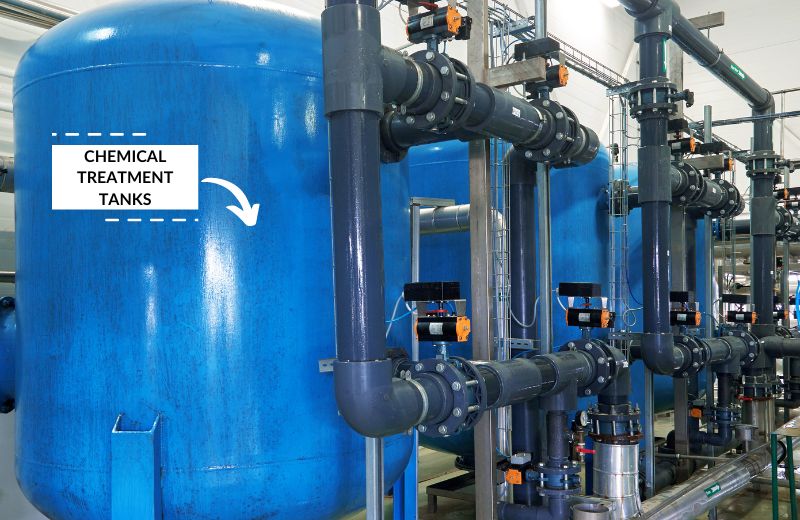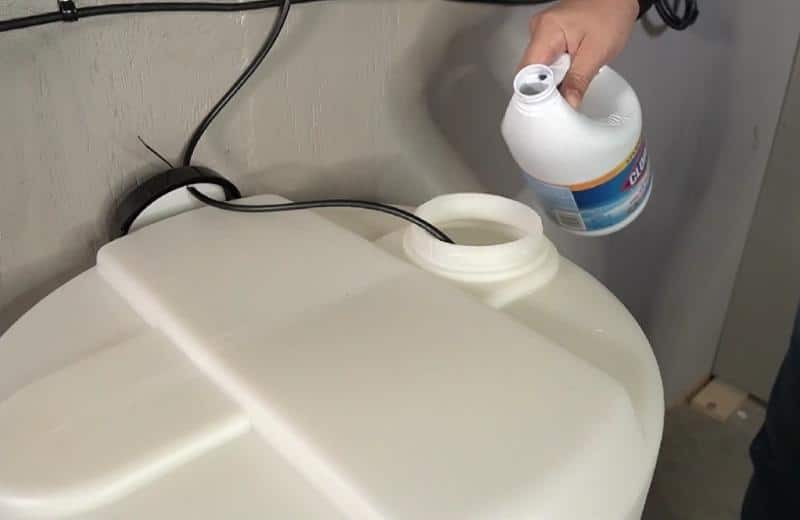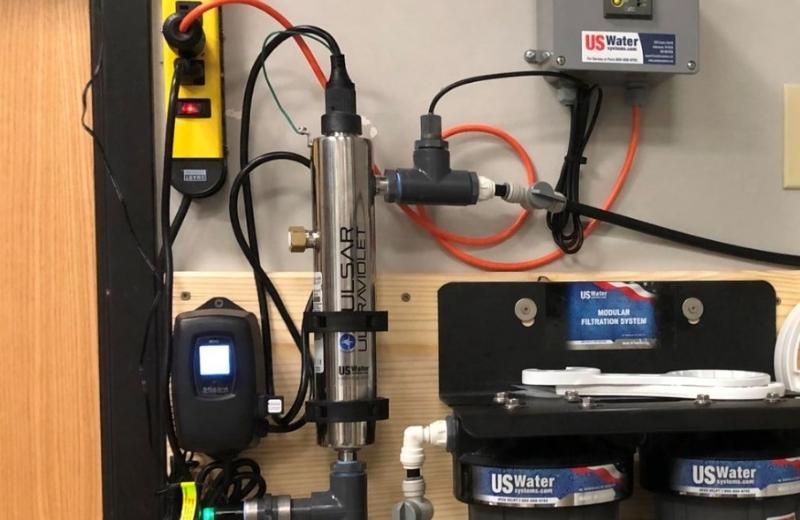Disinfection is a key stage in the treatment of drinking water and wastewater.
In this guide, we’ve shared everything you need to know about water disinfection, including what it is, how it’s employed, why it’s needed, and more.
📌 Key Takeaways:
- Disinfection is the process of killing pathogenic microorganisms and making water potable (safe to drink), usually with the use of chemicals.
- Water disinfection is needed to prevent the spread of waterborne diseases.
- The most common disinfection chemicals include chlorine dioxide, chloramine, ozone, and iodine.
Table of Contents
- 🤔 What Is Water Disinfection?
- 🧪 How Does Water Disinfection Work?
- 🧐 Why Is Water Disinfection Needed?
- 📥 What Concentration Of Disinfectants Are Used To Treat Water?
- 🚰 Common Disinfectants Used For Water Treatment
- ⚖️ Pros & Cons Of Chemical Disinfection
- ✅ Chemical-Free Methods Of Disinfection
- ⚗️ Is Water Disinfection Always Used?
- ❔ Water Disinfection FAQ
🤔 What Is Water Disinfection?
Water disinfection is the term for when water is treated with chemicals or UV light to kill bacteria, viruses, and other waterborne pathogens.
By destroying or deactivating microorganisms, disinfection prevents these harmful impurities from growing and reproducing.

🧪 How Does Water Disinfection Work?
Water disinfection is usually employed as a final water treatment stage, after water has been filtered and enhanced with coagulation, flocculation, sedimentation, and physical filtration.
Measured amounts of disinfectant chemicals are injected into the water. Water is held in a storage tank for long enough for the chemicals to take effect and kill all the microorganisms.
Often, this initial disinfection stage (known as primary disinfection) is followed by a second disinfection stage (known as secondary disinfection), which provides further protection against disease-causing organisms as water travels through the distribution pipes to household water systems.
👨🔧 Find out more about the different stages of water treatment in this article.
🧐 Why Is Water Disinfection Needed?
Water disinfection is needed to prevent waterborne disease.
A raw water source, especially a surface water source (such as river or lake water) could be contaminated with waterborne bacteria and other pathogenic microorganisms due to animal waste, or runoff from nearby sewers and septic systems.
Parts of the water distribution system (which delivers water to homes and businesses) could also be contaminated with microorganisms.
The only way to kill these pathogens and prevent disease is to disinfect the water.

📥 What Concentration Of Disinfectants Are Used To Treat Water?
The exact concentration of disinfectant chemicals used to treat water depends on several factors, including:
- The quality of the untreated water
- The volume of water treated
- The type of chemical used
- How far the treated water must travel in the distribution system
To give an example, the Environmental Protection Agency (EPA) has set a legal limit of 4.0 mg/L (milligrams per liter) for total chlorine. This is the maximum residual disinfectant level that can be present in water.
So, public water systems must make sure to minimize their chlorine levels to below the EPA limit, while still providing thorough enough chlorination to eliminate the threat of waterborne disease.
The normal range of chlorine for drinking water disinfection is 1.0 to 4.0 mg/L . You can view your Consumer Confidence Report to learn the volume of chemicals added to your water supply at the treatment plant.
🚰 Common Disinfectants Used For Water Treatment
There are tons of disinfectants that may be used for treating drinking water or wastewater.
The most common disinfectants are chlorine and chloramine (combined chlorine and ammonia). Ozine and iodine may also be used for community water disinfection.
The full list of disinfectants that may be used to treat water are:
- Chlorine
- Chlorine dioxide
- Chloramine
- Ozone
- Hypo chlorite
- Iodine
- Bromine
- Bromine chloride
- Copper
- Silver
- Calcium hypochlorite
- Hydrogen peroxide
- Sodium hypochlorite
- Alcohols
- Fenols
- Several types of bases and acids
These chemicals and substances have largely the same effect in water: they kill microorganisms and greatly reduce the potential for disease.

🔎 How To Find Out Which Disinfectant Is Used In Your Water
The best way to find out which disinfectant is used in your water is to check your Water Quality Report.
All local water utilities are required to produce an annual Water Quality Report, or Consumer Confidence Report, for their customers. You should be able to find your Report online by searching “your local area* Water Quality Report *year*”
This Report should list information about how your water is treated, including the disinfection chemicals used. If you can’t find this information, check the water utility’s website or reach out to customer support.
⚖️ Pros & Cons Of Chemical Disinfection
Below, we’ve outlined the key benefits and setbacks of disinfecting contaminated water with chemicals:
Pros:
- Chemical disinfection protects water throughout the distribution system. Chemicals are retained in the water, protecting against disease-causing microorganisms throughout its journey to homes and businesses.
- Chemical disinfectants are cheap. Although chlorine demand is high, this chemical is easy to produce and widely available, making it affordable for large-scale use.
- Chemical disinfection retains the quality of the distribution system. Disinfection chemicals also destroy algae and mold that grow in water pipes and storage systems, helping to retain their quality and cleanliness.
Cons:
- Disinfection with chemicals alters water taste. Many people find the “swimming pool” chlorine taste of chemically disinfected water unpleasant.
- Chemical disinfection of drinking water produces byproducts. Chlorination byproducts have major health concerns, including an increased likelihood of several cancers.
- Most chemical disinfectants are toxic in large amounts. You may not wish to drink even small concentrations of these chemicals in your water.
✅ Chemical-Free Methods Of Disinfection
The most common disinfection process for large-scale water treatment involves the use of chemicals. Why? Because chemicals offer the cheapest way to disinfect water. They’re also widely available and can be stored for relatively long periods before use.
However, a select few water treatment plants use alternative chemical-free disinfection methods to ensure their drinking water supplies are potable and microbiologically safe.
The most popular chemical-free disinfection method is UV purification. This method uses UV light to kill microorganisms by scrambling their DNA, preventing them from reproducing or causing waterborne diseases. UV purification takes just seconds – water is disinfected instantly as it flows through the UV chamber.
While UV purification has the advantage of being completely natural and adding nothing harmful to water, it does have a few setbacks.
The main disadvantage is that UV disinfection doesn’t ensure that a water supply doesn’t become contaminated in the water distribution system because, unlike chemicals, UV light doesn’t linger in water.
Plus, UV purification only works effectively on clear, non-turbid water. Water with a lot of suspended particles may not be fully disinfected because the particles will shield the microorganisms from the UV rays.
There are a few other physical disinfection methods, including the use of electronic radiation, gamma rays, and heat, but they’re not commonly used in large-scale applications.

⚗️ Is Water Disinfection Always Used?
In the case of drinking water treatment, yes, water is almost always disinfected before it’s distributed to customers.
Even when water sources are highly unlikely to be contaminated by microorganisms (such as groundwater supplies), low levels of chemical disinfectants are usually still added as a precautionary measure.
Water disinfection also eliminates the risk of water being contaminated by microorganisms during storage in holding tanks and distribution in underground pipes.
❔ Water Disinfection FAQ
Why is disinfection important in water treatment?
Disinfection is important in water treatment because it prevents the spread of waterborne disease, this protecting public health. Microorganisms like Cryptosporidium and Giardia may have harmful health effects if consumed in water. Some waterborne diseases may even be deadly to vulnerable populations, so eliminating their risks by disinfecting water is essential.
What are the 3 most widely used disinfectants in wastewater treatment?
The three disinfectants that are most commonly used in wastewater treatment are chlorine, ozone, and chloramine. Some wastewater treatment plants also use a chemical-free disinfection process called UV purification.
What kills viruses in water?
A number of chemical disinfectants are effective at killing viruses in water. These include chlorine, chloramine, ozone, and iodine. UV treatment can also be used to kill viruses without the need for chemicals.
Is chemical water disinfection safe?
Yes, for the most part, water disinfection with chemicals is considered safe because only small, managed amounts of chemicals are added to the untreated water (just enough to kill bacteria and other microorganisms). However, most forms of chemical water disinfection react with naturally occurring organic matter to produce disinfection byproducts, which (according to the Centers for Disease Control) may have dangerous health effects, including cancer.
What is the most common drinking water disinfectant?
Chlorine is the most common and widely-used drinking water disinfectant in the US. Alternatives to chlorine disinfection are chloramine and ozone, which have similar chemical properties and produce near enough the same results.
What’s the difference between water sterilization and disinfection?
Water sterilization involves killing or deactivating all microorganisms – both harmful and unharmful. Disinfection, on the other hand, has the main goal of killing or deactivating only the microorganisms that may cause us harm.
